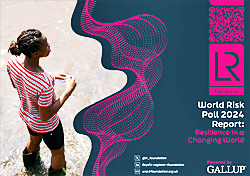John Southwell. Tec IOSH. AIIRSM. RSP
of CWU's Lancs and Cumbria Branch, and Secretary of the NW BT Unions Health & Safety Co-ord has forewarded to unionsafety website; a report into the levels of resilience and concern people have across the globe to their ability to deal with the Earth's current dangers caused by climate change.
 The report entitled The World Risk Poll, explains in its summary, that it is the first and only global, nationally representative study of worry about, and
harm from, risks to people’s safety.
The report entitled The World Risk Poll, explains in its summary, that it is the first and only global, nationally representative study of worry about, and
harm from, risks to people’s safety.
The reports executive summary explains:
The Poll is based on nearly 147,000 interviews conducted by Gallup in 142 countries and territories throughout 2023 and covers places where little to no official data on safety and risks exist.
It measures 120 of the same countries surveyed in the previous Poll in
2021. The 2023 World Risk Poll provides the second edition of the World Risk Poll Resilience Index –
a unique measure of how prepared people and communities worldwide are to handle adversity such
as disasters based on their circumstances and perceptions of support systems.
The Poll is a unique resource for defining the nature and scale of safety challenges across the world,
as reported first-hand by those who experience them. Governments, regulators, businesses, NGOs
and international bodies can and should use this freely available data to inform and target policies
and interventions that make people safer.
The full report can be downloaded from the unionsafety E-Library by clicking on the report's cover image below.
Some of the main findings as summarised:
Overall resilience remains similar to 2021, but results varied significantly
across the four dimensions of the index
• Overall, the world’s resilience remains largely similar in 2023 compared to 2021 (scoring
57 vs 55 on the Resilience Index, respectively). Three-quarters of countries and territories
(90 of 120) measured in both 2021 and 2023 saw no significant change in Resilience Index
scores.
• This general sense of stability belies more significant variation across the four resilience
sub-indexes – individual, household, community and societal.
- More countries (20) saw significant declines of four points or more than saw significant
increases (eight countries).
- While overall resilience was stable at a global level from 2021 to 2023, resilience at the
individual level fell, with significant drops in over a third (42) of countries measured in both
years. Many of the largest declines were observed in Eastern Europe.
 - This decline in individual resilience was driven by a global increase, from 36% to 43%, in the
percentage of people who say they can do nothing to protect themselves and their families
from the impact of a future disaster, suggesting a global loss of agency and growing sense
of helplessness.
- This decline in individual resilience was driven by a global increase, from 36% to 43%, in the
percentage of people who say they can do nothing to protect themselves and their families
from the impact of a future disaster, suggesting a global loss of agency and growing sense
of helplessness.
- The index shows that individual and household resilience have positive associations with
each other, as do community and societal resilience – improving one can potentially
positively affect the other.
• Many countries that saw the largest increases in overall resilience have experienced
profound instability since 2021, including Russia, Burkina Faso, Ukraine, Mali and Lebanon.
These increases in overall resilience were driven by increases in the community and societal
dimensions.
The implications for Government's policy changes are significant:
The World Risk Poll data and insights highlight several policy interventions which could be
implemented to improve people’s resilience in the face of disasters.
These include:
1. Early warnings: Significant inequalities remain in access to early warnings.
The data show that
certain global regions, such as Central, Western and Northern Africa, should be particular
areas of focus to improve early warnings to people, and within countries, people with the
lowest levels of education, those who live in rural areas, and those with the lowest levels
of financial resilience have the greatest need for more early warning dissemination.
Mobile
phones and digital early warning systems could represent a key opportunity to narrow these
gaps in access to early warning systems.
2. Focussing on the most vulnerable demographic groupings within countries:
 The data and
analyses show that some demographics have much stronger associations with high scores
on the Resilience Index than others. People not in full-time employment for an employer, the
poorest 20% of income earners and the elderly should be of particular focus for support to
improve their resilience.
The data and
analyses show that some demographics have much stronger associations with high scores
on the Resilience Index than others. People not in full-time employment for an employer, the
poorest 20% of income earners and the elderly should be of particular focus for support to
improve their resilience.
3. Financial safety nets:
There is a clear link between resilience and how long households could
cover their basic needs if they lost their income. Strengthening people’s financial safety nets,
particularly for women, is therefore likely to help people survive and recover better from
disasters in the future.
4. Targeted interventions
Starting at the individual and household levels to improve the sense
of urgency: Interventions to improve resilience need to engage with people and communities
to reinforce messages that there are measures people can adopt to reduce the risks of harm
from disasters and strengthen their resilience.
The report has been backed by the Lloyd’s Register Foundation which is an independent global safety charity that supports research,
innovation, and education to make the world a safer place. Its mission is to use the best evidence
and insight, such as the World Risk Poll, to help the global community focus on tackling the world’s
most pressing safety and risk challenges.
See also: Fashion - A Major Threat To The Planet Helping To Speeds Up Climate Change


 The report entitled The World Risk Poll, explains in its summary, that it is the first and only global, nationally representative study of worry about, and
harm from, risks to people’s safety.
The report entitled The World Risk Poll, explains in its summary, that it is the first and only global, nationally representative study of worry about, and
harm from, risks to people’s safety. - This decline in individual resilience was driven by a global increase, from 36% to 43%, in the
percentage of people who say they can do nothing to protect themselves and their families
from the impact of a future disaster, suggesting a global loss of agency and growing sense
of helplessness.
- This decline in individual resilience was driven by a global increase, from 36% to 43%, in the
percentage of people who say they can do nothing to protect themselves and their families
from the impact of a future disaster, suggesting a global loss of agency and growing sense
of helplessness.